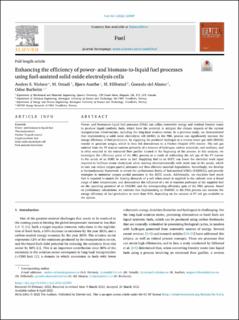| dc.contributor.author | Nielsen, Anders | |
| dc.contributor.author | Ostadi, Mohammad | |
| dc.contributor.author | Austbø, Bjørn | |
| dc.contributor.author | Hillestad, Magne | |
| dc.contributor.author | del Alamo Serrano, Gonzalo | |
| dc.contributor.author | Burheim, Odne Stokke | |
| dc.date.accessioned | 2022-11-23T13:44:50Z | |
| dc.date.available | 2022-11-23T13:44:50Z | |
| dc.date.created | 2022-04-19T11:23:09Z | |
| dc.date.issued | 2022 | |
| dc.identifier.issn | 0016-2361 | |
| dc.identifier.uri | https://hdl.handle.net/11250/3033702 | |
| dc.description.abstract | Power- and biomass-to-liquid fuel processes (PBtL) can utilize renewable energy and residual forestry waste to produce liquid synthetic fuels, which have the potential to mitigate the climate impacts of the current transportation infrastructure, including the long-haul aviation sector. In a previous study, we demonstrated that implementing a solid oxide electrolysis cell (SOEC) in the PBtL process can significantly increase the energy efficiency of fuel production, by supplying the produced hydrogen to a reverse water gas shift (RWGS) reactor to generate syngas, which is then fed downstream to a Fischer–Tropsch (FT) reactor. The tail gas emitted from the FT reactor consists primarily of a mixture of hydrogen, carbon monoxide, and methane, and is often recycled to the entrained flow gasifier located at the beginning of the process. In this analysis, we investigate the efficiency gains of the PBtL process as a result of redirecting the tail gas of the FT reactor to the anode of an SOEC to serve as fuel. Supplying fuel to an SOEC can lower the electrical work input required to facilitate steam electrolysis when reacting electrochemically with oxide ions in the anode, which in turn can reduce oxygen partial pressures and thus alleviate material degradation. Accordingly, we develop a thermodynamic framework to reveal the performance limits of fuel-assisted SOECs (FASOECs) and provide strategies to minimize oxygen partial pressures in the SOEC anode. Additionally, we elucidate how much fuel is required to match the heating demands of a cell when steam is supplied to the cathode over a broad range of inlet temperatures, and demonstrate the influence of a set of reaction pathways of the supplied fuel on the operating potential of an FASOEC and the corresponding efficiency gain of the PBtL process. Based on preliminary calculations, we estimate that implementing an FASOEC in the PBtL process can increase the energy efficiency of fuel production to more than 90%, depending on the amount of FT tail gas available to the system. © 2022 The Authors | en_US |
| dc.description.abstract | Enhancing the efficiency of power- and biomass-to-liquid fuel processes using fuel-assisted solid oxide electrolysis cells | en_US |
| dc.language.iso | eng | en_US |
| dc.publisher | Elsevier | en_US |
| dc.rights | Navngivelse 4.0 Internasjonal | * |
| dc.rights.uri | http://creativecommons.org/licenses/by/4.0/deed.no | * |
| dc.title | Enhancing the efficiency of power- and biomass-to-liquid fuel processes using fuel-assisted solid oxide electrolysis cells | en_US |
| dc.title.alternative | Enhancing the efficiency of power- and biomass-to-liquid fuel processes using fuel-assisted solid oxide electrolysis cells | en_US |
| dc.type | Journal article | en_US |
| dc.type | Peer reviewed | en_US |
| dc.description.version | publishedVersion | en_US |
| dc.source.volume | 321 | en_US |
| dc.source.journal | Fuel | en_US |
| dc.identifier.doi | 10.1016/j.fuel.2022.123987 | |
| dc.identifier.cristin | 2017521 | |
| dc.relation.project | Norges forskningsråd: 267989 | en_US |
| cristin.ispublished | true | |
| cristin.fulltext | original | |
| cristin.qualitycode | 2 | |

